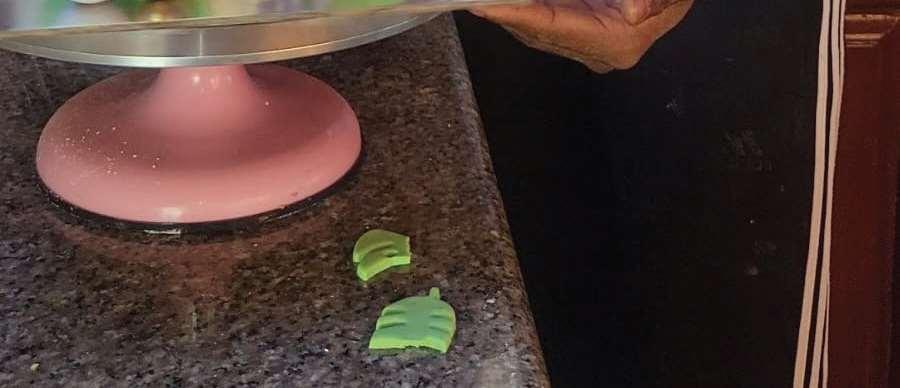NEETAMangaldoesn’tmindbeingimmersedinanimal welfaresincesheisanavidanimaladvocatewhoregularly mistreatedandabandonedanimals.
ThemotherofonetoldPepperpotMagazinethatshepresentlyhas22catsand22dogs,mostofwhichwererescued fromdiresituationsorabandoned.
Sheexplainedthatgrowingup,shewasalwayssurroundedbyanimals,andherloveforthemdeepenedasshe
gotolder,developingastrongconnectionwiththem.This encountersdaily.
itpainsme.Iam compelledtoassist,evenifIhave totakethatdogorcathomewithmetofosterthemuntilI chosethis,andIfeelitchoseme,too,becauseitfeelsfulnotaone-timething,”sheexplained.
Mangalreportedthatherdaughter,whoisalsoananimal lover,assistsherinfosteringdogsandcatsattheirhome.
Sheaddedthatasavolunteerinanimaladvocacy,fosteringanimalsinvolvesalotofwork,especiallygiventhe numberofanimalstheyhaveathome.Theyareconstructing alargeenoughcagetoaccommodatealltheanimalssothey donotroamaroundandcauseissueswithneighbours.
MangaltoldPepperpotMagazinethatshehasbeen forcedtomovefourtimesandrecentlyrelocatedtoAnnandale,EastCoastDemerara,wheresheisrenting.Theowner oftendoesnothavethespacetoaccommodatesomany animalsaltogether.
Shedisclosedthatsheisawaitingthetitleforherhouse lotsoshecanstartconstructingherveryownhousewith adequatespace(asanctuary)fortheanimalsinhercare.
The50-year-oldstatedthatfosteringanimalsisherway oflife,andshehasbeendoingwhatevershecantogive themabetterlife,thoughmanyareoftennotadopted.
Presently,shecannottakeinanymorecatsanddogs becausesheisoverwhelmed,butshewillcareforthose shehas.Shewouldappreciatedonationsofpetrice,dry dogfood,andcatfoodtosustainthedailyfeedingofallthe animalsinhercare.
aburdenbecauseshetreatsthemaspartofherfamily,and sheisproudthather29-year-olddaughterhasadoptedher habitofbringinghomestraysandanimalsthatneedahome.
Theanimallovernotedthatshehasajobthreetimesper week,whileherdaughterhasafull-timejob,andtheyboth strivetoprovidemealsdailyfortheanimals.
Mangalreportedthat,sometimes,shereceivesadonationofabagofdrydogfood,butlately,peoplehavenot beencontributingastheydidbefore.Shehasthehelpoftwo peoplewhoassistherinfeedingandthegeneralupkeepof theanimalsdaily,whichisabighelp.
Mangalpointedoutthat, attimes,peopleadoptthe
Catsandadogsharingspace
NeetaMangal
NeetaMangalandone ofher22 dogs
ByMichelOutridge
THEGuyanaLotteryCompany(GLCL)wasestablishedinGuyanainearly1996withthelaunch ofInstantTicketgames, followedbythe3DdailynumbersgameinFebruary1997.Thehighly demanded“Lotto”game, nowtheLottoSupergame, waslaunchedinMay1997. Sinceitsinception28years ago,thecompany,through itsvariouslotterygames, hashelpedthousandsof Guyanesetorealisetheir dreamsandhasmadea positivecontributionto thesocialandeconomic landscapeinGuyana.Additionally,thecompany hascontributedbillionsof dollarstothenationaltreasury,whichhasbeenused forthesocialandeconomic developmentofGuyana.
Recently,PepperpotMagazinemetwithKalimaAli, thenewlyappointedGeneral Manager,tolearnmoreabout thelotteryanditsimpactin Guyana.Aliexplainedthat thecompany’sexistencein Guyanagoesbeyondthe lotteryitself,and,overthe years,ithascontributedsig-
thecompanyhassupportedgoodcausesviacomeducationalneeds,among others,aslongasthesefall withintheirpolicygoverningdonations.“Wehave assistedinbreastcancer viadonationsoftrophies fortopperformersatexams,andtowardslibraries, orphanages,maternaland childcarehealth,sportsactivities,youthandcommunityempowerment,careand socialisationfortheelderly, amongmanyotherareas.”
Alinotedthatbecauseit isalotterycompany,people oftenbelievetheyhavea lotofmoneytodonate.She sharedthatshewouldbe elatedtorespondtoevery request,butunfortunately, thatisnotpossible.Nonetheless,sheexplainedthat throughthewinningsfrom variousgames,thebiggest beingtheLottoSuper6, manypeople’sliveshave changedpositively.
ticket.
“Thisiswhatthelottery represents—anopportunityformanytorealisetheir dreamsandaspirations,”Ali explained.
TheGeneralManager ofGLCLhighlightedthat thecompanyisverymuch interestedincontinuingto growinGuyanaandexpand itscommunityengagements causes.Throughvariousmarketinginitiatives,thecompanyhasincreaseditsoutreach tocommunities,recently engagingwithresidentsin Vreed-en-Hoop,WestCoast Demerara;Parika,EastBank Essequibo;NewAmsterCorentyne,wheretheywere well-receivedandhadpositiveengagementswiththe public.
TheGuyanaLottery Companyhasbecomea householdnametomany andisseenasatrustedpartner.Alipointedoutthatthese publicinteractionswerebenastheyexpandthroughout Guyana.
inmanyareastopromote positivecommunityengagementsandsocio-economic development.
ShetoldPepperpotMagazinethat,whiletheydonot conformtoanydesignated charitableorganisations,
Mostoftheplayerswho havewonlotteryprizesusuallyre-investtheirwinnings intoenhancingtheirlivesby childrenandfamilies,buyinghomesandproperties, andinvestinginbusinesses, amongotherthings.Thishas allowedGuyanesetocreate abetterstandardofliving forthemselves,theirfamilies,andtheircommunities
TheGuyanaLotterylicdrawingonWednesday, February27,2002,outside thethen-SubwayFastFood outletonWaterStreet,with hopesofholdingmorepublic drawingsinthefuture.
prize.Hestartedplayingthecameawinner.Heindicated thathewouldusethemoney investinhisownbusiness.
Aliaddedthatthisis justoneofmanysuccess storiestheyhavehadwith peoplewhowonandused themoneytoimprovetheir livesandbecomedebtfree,aswellasraisetheir standardoflivinginmany ways.Therearemanysuccessstoriesofhowwinners haveutilisedtheirwinnings toupgradetheirlivesand secureabrightfuturefor themselvesandtheirfamilies.Itwouldbeinteresting toconnectwithallpast winners,shesaid.
TheGLCLprovidesdirectfull-timeemploymentfor LamahaStreetandattheirre-
potwinnerwalkedintothe
attheGuyanaPostOffice CorporationBuildingandin NewAmsterdam,Berbice. Indirectly,thecompanyemploysmorethan200agents acrossthecountrywhoreceivecommissionsoneach ofthegamesandproducts theysell.
Manybusinessowners, especiallysmallbusiness owners,areinterestedin sellingGLCLproductsas itbooststheirbusiness. Throughitslotteryproducts,GLCLpromotesthe businessesofmanysmall businessownersacrossthe countrywholookforward
totheirsizablecommissions onsales.
Inaddition,theyhave twoBlastCentresforvirtual lotterygamesandtraditional lotterygames,whichcaterto moretech-savvycustomers. ThesearelocatedatMandelaAvenue,Georgetown, andatEnmore,EastCoast Demerara.
Regardingunclaimed winnings,Alisaidtheydo nottouchthosefunds.She explainedthattheywould advertiseforwinnerstocome forwardassometimespeople areunawaretheyhavewona prizeormayhavemisplaced winningtickets.Afteraperiod,however,theycannotdo anythingfurther.Shepointed outthattheycanonlyknow wherethewinningticketwas purchasedbutcannotidentify winners.
AlitoldPepperpotMagazinethatplayingthelottery isnormal,andforthepast28 years,theyhavebeendoing businessinGuyana.Agents andstaffhavebecomefamiliarwiththeregularplayersandothers,andtheydo keepaneyeontheirgaming activities.Sheaddedthat thecompanyhasverystrict policiesthatareenforcedto ensureresponsiblegaming, andticketsareonlysoldto persons18yearsandolder.
Alidisclosedthatsince theirdebutinGuyana,50% remainwiththecompany, andtheGLCLisagoodplace towork,astheenvironment isfavourable,withpriority
development.
AlibecametheGeneral ManagerofGLCLonAugust GLCL,sheheldmultiplelicsectorandinternational community,includingroles GuyanaGamingAuthority, theMinistryofAmerindian Affairs,andformerlythe GovernmentNewsAgency (GINA).
Alihasheldtoppositionsintheseorganisations foryears,soshebringsa mixtureofbothlocaland internationalexperienceand aclearstandardtotheGLCL. Hervisionisthecontinued growthofthecompanyby expandingitsbusinessoperations,improvingcustomer satisfaction,fosteringgood relationswithallstakeholders,enhancingemployee engagement,andgivingback tothelocaleconomy.
Meanwhile,Marketing Manager,DonielleBarnes, addedthattheGLCLhas alwaysbeenattheforefront ofcontributingtosocietyin ameaningfulway,especiallywherecommunitiesare explainedthattheyhave aclearscopeinengaging stakeholdersandexpanding theirproductsacrossthe country.Barnesstatedthat theyremaincommittedto fosteringgoodcustomerment.
GuyanaLotteryCompanyhelpingGuyanesetorealisedreamsfor28years
Donielle Barnes.
Makingthewaterspartofhislifestyle
ByMichelOutridge
SAMUELRamroop,better knownas“Sammy”,has othermeansofearninga living,buthepreferstoprovideareliable,safeservice tothepublicviahistwo speedboats,whichplythe ParikatoSupenaamroute.
The38-year-oldtoldPepperpotMagazinethatasa youngman,healwayshad aninterestinbeingself-employedandworkedtowards thatlifegoal.Hereported thathecomesfromafamily offarmers.Atayoungage, hewasintroducedtofarming butalsohadagreatlovefor workingwithspeedboats,a skillheusedtobringinextra income.
Ramroopbeganworkingersontheirboatsuntilhegot
licensedasaspeedboatcaptain.Itwasaftersevenyears
thattime.
tobuyhisownspeedboats theParika/Supenaamroute, providingasafeservicefor passengers.
Ramroopaddedthat ittookhimmanyyearsof workingandlearningto movefromabowmantoa boatcaptain,butitwasworth itbecauseoftheexperiences andknowledgegainedduring
Thefatherofonesaidthat hardworkandtruededication abletoacquirehisownboats, namedTouchandLetGoand Senorita.
Thetwospeedboatsareerengines,andhehasanothengine,whichisonlyused forfarmingpurposes,suchas takinghisproducetoParika Stellingtoselltowholesale
buyers.
Ramroopstatedthathe losthisdaughtertoaroad wasonherwayhomefrom school,andhedoesnotthink hecanrecoverfromthat. Despitesuchchallenges,he haspushedaheadtobecome thebestversionofhimself inmanyways,including becomingafarmerandafulltimespeedboatoperatorwho captainshisownboatwhile employingothers.
Ramroopisafriendlyand kindindividual—qualities thathelphimmaintaingood relationswithpassengersvicetothetravellingpublic.
“Asaboatcaptain,Itake safetyseriouslybecauseIam responsibleforthepeople travellingonmyboats.Itis inorderwithallsafetymechanismsinplace,including lifejackets,whichmustbe wornatalltimesduringthe journey.Iadheretoallsafety measuresandstipulations, andIamregisteredwith theMarineAdministration Department(MARAD),”he said.
Ramroophasgainedmuch knowledgeandhascome tolovewhathedoesfora living.Oneofhisfavourite placestovisitisBaganara Resortforthecleanenvironment,whichisserene,and forthestaff,service,and
Boatcaptain,SamuelRamroop
Oneofhistwospeedboatsmoored
PakchoicultivationatHoggIsland
ByMarissaV.Foster
THEartofbakingand cakedecoratinghasoften beencategorisedasawomthis,JonathanParshotam, artistwhoisshininginthe industrywithhiscreativityamazingneighbours.HemaryandJ.C.Chandisingh Secondarybeforemovingon -
Hedescribedhisupbringingasverysimple.“Wedidn’t haveeverything,butwhatwe hadwaswhatweneeded,”said Jonathan.Hisparentstaught himvaluesthatheusestothis veryday,andtheyensured heshowedloveregardlessof appearance.Thesevalueshave provenvitaltohissuccess inbusinessandotherchosen paths.Theinstilmentofagood workethicandthepursuitof greatnessiswhatallowedhim todefyallodds.
PepperpotMagazineasked Jonathanwhatinspiredhim tostartacakebusiness,and herespondedbysaying,“My motheractuallystartedthis
business.Itwasnamedafter her,‘Sabrina.’”Heremembers watchinghermakethesecakes andalwayswonderedhowit wasevenpossible.Forhim,it wasanewworld,anditcertainlypiquedhisinterestandimagination.“Itookthebaitandwent downto‘YouTubeUniversity’, asIcallit,andsoakedupallthe knowledgeIpossiblycould.”
Hewantedtolearnasmany skillsashecouldtocontribute tothebusiness.Hestartedby takingpicturesandpackaging thecakes,andlater,hebe-
BerbiceCakeArtist,JonathanParshotam
JonathanParshotamintheprocessof completingaSafarithemecake
BringingvisibilitytoRealEstate
LocalAgent’suniqueapproachonsocialmediatoleveragemorebusiness
ByMarissaV.Foster.
GUYANAisdevelopingits landscapethroughinfrastructuraldevelopments suchasinternationalhotels,franchisedcentres, andmodernhousing.Real estateisoneofthemany rapidlygrowingfields, withprofessionalssuchas SelenaBacchus,working toraisethestandardsin theindustry.Selenacurrentlyleveragesrealestatesalesandinvestments throughinnovativesocial networkingtechniques.Usingherknow-how,Selena hasmergedcontentcreation,marketing,andreal estateonhersocialmedia platforms.
Selenaexplainedthat herstrategyvariesbasedon thesocialmediaplatform sheuses.“Forinstance,my TikTokaccountseesmore humourrelatedtorealestate,whereasmyLinkedIn postsarealotmoreprofessionalandinformative.For FacebookandInstagram, I’mmorerelaxedwithmy contentsurroundingrealestate,”shesaid.Herwinning
incorporatehumourintoreal estatecontent.
Asachild,Selena andherfamilyfrequentlymoved,allowingherto experiencebothruraland urbanlife.Shewasexposed topeoplefromallcultures andwalksoflife,further enhancingherabilityto relatetoothers.Herfamilyownedabusinessthat allowedfrequenttripsto Guyana’sinterior.Asaresult,shealternatedschools inGeorgetownandMahdia. Sheattendedprivateschools formostofhereducational years.ShecreditstheSchool oftheNation’sprogramme forhelpingherduringthose years.Selenawasastudent therefromGradeThree andisnowcompletingher MasterDegreeatthesame institution.
Selenaisfortunateto havefoundateamandcompanyatKellerWilliams Guyana,aninternational realestateagencythatsupportsherinbeingherauthenticselfandallowsher toprojectherownbrandinto herwork.Selenadescribed realestateasanaturalprogressionfromherlovefor marketingandearlierwork
experienceinbothsalesand marketing.Shehascreated animmensenetworkover thelastfouryears,andthese connectionshaveproven valuableinhertransitionto therealestatemarket.“In mymind,Isimplymoved fromsellingbusinessservicesandconsumerproducts tosellinghousesandland,” stressedSelena.Thestrategiesandplatformsused toreachclientsremained thesame.Shebelievesher mainpurposeistoconnect peoplewithotherpeopleor organisations.
PepperpotMagazine questionedSelenaonthe challengesoftherealestateindustry,towhichshe replied,“Thechallengeis definitelythepaceofthe trade.It’salmostaratrace whereclientswillquickly moveontothenextagent ifyouaren’tengagingthem almostimmediately.That beingsaid,personaltime canquicklybeeatenupwith customerengagementifyou aren’tstrictwithworking timesandboundaries.”Selenaemployssimpletactics likeinstantmessagesor automaticresponses,along withmuchofthetechnology providedbyKellerWilliams
SelenaBacchus
Guyana,tohelpherwiththis dilemma.
Shehighlightedtherealitiesoftherealestateindustry inGuyana,explainingthat thereisnosecretthatreal estatepricesare“jackedup.” However,increasedpricing issimplyaconsequenceof thelowsupplyofhousingin themarket,andasthebasic lawofeconomicsstates, “Ifdemandoutweighssupply,pricewillrise,”and that’swhatGuyanahasbeen experiencing,saidthistop emergingrealestateagent. Asdeveloperscontinueto buildhomes,apartments,and commercialandindustrial buildings,priceswillreduce. AccordingtoSelena,thisis alreadyevidentontheEast BankofDemerara.There hasbeenamassiveincrease inthenumberofrealestate developmentsconcentrated intheProvidenceareain lessthanfiveyears.Now, demandhasmigratedtothe EastCoast,followingdevelopmentslikeExxonMobil’s
Selenalooksforward tocreatingmorecontent, andcombatingmisinformationaboutrealestate agentswhileexpanding herclienteleandnetwork throughhumourandauthenticity.“Ilovehowversatilemypracticecurrently isasIhandleresidential, commercial,andindustrial deals,”saidSelena.She looksforwardtospecialisinginanichethatwill makehermoreprominent intheindustry.Formore onhercontentandcareer, youcanvisitherTikTok account:@yourrealestatebestiegy.
-ANewCollectionofStoriesbyCyrilDabydeenthatexploresidentity,belonging,andtheimmigrantexperience
WITHthereleaseofhislatestbook,ForgottenExiles, Guyanese-Canadianwriter, CyrilDabydeen,continues tocaptivatereaderswith hisexplorationsofidentity,belonging,andcultural dislocation.Knownforhis sharp,evocativestorytelling,Dabydeen’snewshort storycollectionlooksat themesofexileandhomecoming,exploringthecomplexitiesoftheimmigrant experienceinrichdetail. Thebookispublishedby MosaicPressandhasbeen metwithpraiseforitsnuancedportrayalofcharactersnavigatinglifebetween theculturallandscapesof GuyanaandCanada.
Dabydeenwasbornin GuyanaandisaformerOttawaPoetLaureate.Heis celebratedforhiscapacityto rendervividportraitsofhis characters’innerliveswhile addressinglargersocialissues.Hisownjourneyfrom GuyanatoCanadamirrors thetensionbetween“outsider”and“insider”thatdeoftencaughtbetweentheir CaribbeanrootsandNorth Americanrealities.HispreUndiscoveredCountryandilarlytouchedonthemesof displacementandself-discovery.
Asperapressrelease
sharedbytheauthor’s
tricatelycraftedstoriesthat shiftbetweenthewildsof Canada’sLakeSuperiorregionandthebustlingtowns alongthecoastofGuyana.scapeshighlightshisgiftfor seamlesslyblendingcontrast-
ingboundaries”ofbothplace
inrespectedliteraryjourpositionasamajorvoicein Canadianandpost-colonial literature.
ReviewershavehighlightedDabydeen’sability tocapturetheessenceof hischaracters’liveswith languagethatreflectsboth theGuyanesedialectand uniquerhythmand“kaleido-
Seraidescribesit.Thisliterarystyleshowsthedualityof
thepullofahomelandthatis bothphysicallydistantand deeplyembeddedintheir senseofself.
ThroughDabydeen’sersencountercharacterswhoilluminatesocialconcerns
themesofidentityandlongingthatresonatewidely.“Itpinpointingthepoignancy withwhichDabydeencapturesseeminglysimpleyet transformativemoments.
flectsDabydeen’sworkas asocialactivistandeducator.Havingtaughtcreative writingattheUniversityof
Ottawaandparticipatedin literaryeventsaroundthealperspectivetohiswork.cludingnominationsforthe LiteraryAwardandrecognitionfromtheCanadian significanceasacultural CaribbeanandCanadian
SEEPAGEVIII
HUMANbeingsaresocialcreatures.Fromthemoment weareborn,wedependoneachothertolearnhowtoact
oureverydecision,evenasweenteradulthood,wepush ourselvesontoapathwherewenolongergettobeourselves
Today,wecanlookupatthesunandimagineourplanet revolvingarounditWecanhealstomachulcerswiththehelp ofantibioticsWecanmapoutroutesallthewayaroundthe Earthwithoutconsidering,evenforamoment,whetherwe
Thesocialnatureofhumanbeingsisnotalwayscentred aroundtheneedtoformbondsandconnectInsomecases,it issimplyaboutdesiringtobelikedandvalidatedForexample,manyyoungpeoplefollowcelebritiesandtrendsonsocial mediaTheythentakeinspirationfromthesetrendsandcelebritiestoshapepartsoftheirownidentity,suchastheirfashion, language,andeventheirveryappearanceTheydothisnot toformemotionalbondswithcelebritiesbuttoemulatethe qualitiesthatgarneredthecelebrities’praiseandadmiration Thisneedtofollowtrendsandconstantlyseekthepositive opinionsofothersisusuallyharmlessandanormalpartof adolescenceHowever,whenweallowthisneedtoovertake
ofeverydaylife,somuchsothattheyhavebecomeincorporatedintothebasicinformationthatchildrenlearninschool However,onceuponatime,thesefactswerenothingmore thantheories,andthosewhoproposedorsupportedthem wereviewedasbizarreNotonlywerethesegreatthinkers andscientistsridiculed,butsomewerealsopersecutedand forcedtoretractorhidetheirtheoriesunderthethreatof deathTheseverytheorieshavesincebeenproventobefacts ofgreatimportance,servingasthefoundationformanyother areasofresearch
Ourunityandconnectionasacollectivehumanraceare indisputablygreatstrengthsNevertheless,thisveryquality can,insomecases,begintolimitusifweareneverwilling toriskothers’opinionsofusforthesakeofself-discoveryor simplecuriosityIfthegreatscientistsandphilosophersof thepasthaddestroyedeverythoughtandtheorybecausethey fearedhowtheircolleagueswouldviewthem,wewouldnever
haveevolvedasmuchaswehavetoday.
Everyday,wefaceseveraldecisionsthatshapeusasindividuals.Mostofthesedecisionshaveconsequencesthatonly theonlywaywecandispelthepainofpotentialregretsiswith thedeepbeliefthateverydecisionwemadewasforthesake ofeitherourselvesorthegeneralbettermentoftheworldand yourselfwhenyouknowdeepinsidethatyoudidnotmakeit forameaningfulreason?
Wearejustaspowerfulanduniqueaswearesocial.them.Weareallcapableofideasandthoughtsthatare canchangetheworldforthebetter.Letusnotsuppress
literarytraditions.
enrichedhisstorytelling.HispoetrycollectionImaginary Origins:NewandSelectedPoems(PeepalTreePress)is ademonstrationofhismasteryoflanguageandimagery, inpoetics,”revealingthedepthofhisinsightsintotheimmigrantexperienceandthehumancondition. ofcharacterswho,despitethechallengesofdisplacement, demonstrateresilienceandadaptability.Hisstorytellingismersiveworldwhereculturalidentitiescollide,intertwine, andevolve.
amasterstorytellerwithagiftforweavingstoriesthattranscendgeographicandculturaldivides.ForgottenExilesisa aswellastothebroaderconversationonimmigration,identity,andwhatitmeanstobelong.ofawriterwhoseworkcontinuestoshapeCanadianand
FROMPAGEVII
THEEdenquandarytranscendsitsBiblicalnarrative.It
Toevendefytherationaleoftheforbiddenfruitand anyhesitationtoheedwarningsisthenseenasamarkof cowardice,amisunderstandingofthosewhoateandperishedbefore.Itisfurtherinterpretedthatitwasnotthefruit itselfbutratherthehesitation—thechoicenottoactwhen encouraged—thatledtotheconsequenceoflostbalance andthedescentintochaos,asthegameofguilt,blame,and accusationtakesover.Thisdescenteventuallyleadstoeither fatalemotionaloutcomesorseriousphysicalconsequences oferror.
circumstances.
Howshouldsociety,andwhateverrationalintellect existsbutcannotbeunderstood,muchlessintellectually allureofitsunspokensocialdoctrinethatenticesandsubbelievemaybetheanswertothe“EdenQuandary”inour age:thedivisionofgenderegos.Thoughslowlydissipating, Ihavewitnesseditspersistence.
IhadacolleaguewhowasaJusticeofthePeace.He invitedmetohishometocompletesomedocuments,and onthefoldingdesk.Hemurmuredtome,“Itoldthislady I’musingthisdesk,andyetshecontinuestodecorateit withthepaperwork.Afterpayinghim,hewalkedmeto thedoor.Heglancedback,andIfollowedhisgaze.Igesturedingoodhumourandsaid,“Bro,it’sthetable.You asmirk,“Thetablecamewiththevaseandthoseplastic youforit—andseeifanewworkingtablewillsolveit.” Ileftingoodhumour.
Yourfirstdraftisfinished…nowwhat?
OnJanuary16,2014,asa youngwriterinGuyana, Imadeabolddecision:I wouldwriteafull-length thrillernovel.IntheGuyaneseliterarycanon,mostof theworkbycontemporary authorscentresonpoetry andshortstoryanthologies.Inspiredbyadesire toexpandthelocalliterary landscape,Isetouttoconnovel.Iknewsincethen thatthiswouldbeahuge undertaking,giventhechallengesoflimitedresources andanonexistentlocalpublishingindustry.Nearly11 yearslater,inahotelroom inParisinSeptember2024, ofmydebutnovel,Leech.
WhenIstartedthiscolumn,Ididsowiththeaimof sharinginsightsIgainedin myjourneytowardbecoming
aprofessionalwriterinGuyana,includingvariousaspects ofthewritingprocessand optionsforpublishingand earningfromtheirwork.AsI ventureonthisnewjourney, Ithoughtitwouldalsobe usefultosharethestepsI amtakingtobringLeechto publication.
CompletingLeechhas beenoneofthemostchallengingundertakingsofmy life.Toclarify,Ihavenot beenwritingcontinuouslyfor those11years.Cumulatively, I’dsaytheprocesstookabout twotothreeyears.Butin theabsenceofasupportive writingcommunity,resources,andcapacity-building opportunities,thejourney oftenfeltisolating.Writing alonerequiresbothdisciplineandmotivation—two
qualitiesthatareeasierto maintainwithacommunity toleanon.Sowhenwriter’s block,self-doubtandlife disruptionscameintoplay atvariouspartsofthetimeline,lengthystallscamewith them.Throughoutthattime, however,researchbecame mysavinggrace.Isought supportandmetexcellent writingcoacheswhoplayed crucialrolesinhelpingme
tofellowwritersembarking onasimilarjourneyisto considerhiringawriting coach.Butwhileinputfrom experiencedwritersanded-
Iwouldadvisethatyouseek outsomeonewhospecialises inyourgenreforthebest results.Writersoftenbecome deeplyattachedtotheirwork, andacoachcanprovidethe
technicalperspectivetoguide youthroughweaknessesor blindspotsinyourmanuscript.Overtheyears,I’ve hadtheprivilegeofworking withtwoincrediblecoaches whoseguidancehelpedbring Leechtolife.
Hiringawritingcoachsons,aretiredAustralianEn-
distractme-sheknewmeso well.Instead,shefocusedon helpingmeovercomeimmediatechallengesandguided mebackontracktowriting. WhenIfinallycompleted thedraftinSeptember,her responsewas,“CongratulaIhavewonderedaboutyou often.It’soneofthemost interestingbooksIhaveever
Leech,2025
glishteacherandenthusiast guidedmeintransforming Leechfromaone-dimensionalconcepttoanuanced storywithmorerelatable characters,andthattransformationallowedthestorytotakeonalifeofits sometimeafteroursessions concluded,butIhopethe proud.
Later,whenIfoundmyselfonceagainstruggling withwriter’sblock,ImetStephanieMiller,aNew York-baseddevelopmental editorandauthorofBig Waves&WoodenBenches andForgiveMeGrandma, ForIHaveSinned.Stephanie wentthroughthehalf-written manuscriptandthenfirmly withheldherdevelopmental feedback.Sheinsistedthat
essentialandanystructural feedbackbeforethenwould
edited,andIwasgenuinely bummedIonlygottoread halfofit—Ihadtoknow whathappened!”Coachessentialallies.Iamthrilledto nowhaveStephanieonboard asLeech’sdevelopmentaleditor,whichI’llcoverinmore detailinnextweek’scolumn.
Whatcomesnext?
pletingadraft,asmanywill advise,istotakeabreak. Theaimistodistanceyourselffromyourmanuscript, allowingtimeforyourmind toresetbeforeyoudiveinto revisions.However,given thatLeechtooknearly11 yearstocomplete,Ihadalreadytakenplentyofbreaks. Iimmediatelybeganafresh review,assessingthedraftas anexternalreadertoidentify anyissueswithoutyetmakingchanges.Thisstageset thegroundworkforthenext phase:editing.
Editingisamulti-layeredentaspectsofthework.Dependingonthedepthofedits neededandtheavailable budget,writerscanchooseor willbeadvised(iftheyhave ateam)aboutwhichtypes ofeditingtoinvestin.After reviewingmymanuscript,I optedtopursuedevelopmentalediting(addressingstructuralandnarrativeissues) andcopyediting(correcting grammar,spelling,andpuncfeedbackfrombetareaders willfollowbeforepublication.
Iplantounpackeachstep ofthisprocessinupcomingcolumns.Currently,I’m awaitingfeedbackfrommy developmentaleditor,fully awarethatextensivework liesahead.It’sanexciting yetnerve-wrackingphase, butIamthrilledtobeonthis journeyandevenmoresoto shareitwithyou.
Writingcanfeellikea solitaryendeavour,yetit’s crucialtoshareourexperiences,especiallywhen resourcesarelimited.The stepsI’mtakingmaynotbe universal,butIhopethey willserveasusefulguidanceforotherlocalwriters navigatingtheirownpaths topublication.Joinmeas webringLeechtoprint!
GUYANA,likemostthird-worldcountries,hastheambitionofachievingthesocialandeconomicstandardswhich Germany.Guyanaismuchbettersituatedthanmostto achievethosestandardsinashorttimebecauseithas becomeanoilcountryearningfairlybountifulrevenues whichitcouldinvestinsocialandeconomicdevelopment, atthesametimetakingmeticulouscaretoavoidbeing caughtinthetrapoftheDutchDisease.
TheDutchDisease,sometimescalledtheResourceCurse, occurswhenacountrywhichhasbecomeanoilproducer succumbstothemesmerisinggravitationalpullofoilandoil revenues,resultingintheneglectandcontractionofformer industries.Whenoilresourcesbecomeexhaustedorrevenues fallowingtothevagariesofinternationaloilprices,such countriesrapidlyslideintoeconomichardshipbecausetheir otherindustrieswouldhavedeclinedorcontracted.
Guyanaisemployingitsoilrevenuesasaninvestmentin itssocialandeconomicdevelopment.Ineconomicdevelopment,thecountry’sinfrastructureisbeingtransformedwith
newroadsandbridges.Oldindustries,especiallyagricultural, arebeingrevitalised,andnewones,likesoyaandmaise,are beingembarkedupon.Insocialdevelopment,theprimary focushasbeenoneducationandhealth,thoughcomparativelyminorsocialconcernslikepensionsandsheltersforthe homelesshavenotbeenforgotten.Inhealth,forexample,it ismostlythemacrosegmentsuponwhichthemediareports. Itreportsonthenewhospitals,thetrainingofvariouscategoriesofmedicalpersonnel,theconstructionofpaediatricand maternalhospitals,andsoon,butfarlessnoticeisgivento smallerspecialisedsegmentsofhealthcare.Onesuchsegment iseyecareamongchildrenandtheelderly.
Incolonialtimes,publicdiagnosisandtreatmentforeye anddentalailmentsamongschoolchildrenwasextremely sporadic.Mostchildrenwhohaddentalproblemsorneeded spectaclesknewtheirparentswouldhavebeenunabletobear
Today,boththeMinistryofHealthandtheMinistryofEducationarecommittedtoensuringthehealthofallchildren.In eyecare,DrShailendraSugrim,SpecialistOphthalmologist
andHeadoftheOphthalmologyDepartmentoftheGeorgetownPublicHospitalCorporation(GPHC),hasbeenlending technicalexpertiseandguidancetotheprogrammeoftesting theeyesofallschoolchildren,withthosewhoneedspectacles obtainingthemthroughavouchersystem.
DrSugrimpointedoutthatthethreemaineyeailmentspia(far-sightedness),andastigmatism,whichcausesraysof cornea.Allthreecouldbecorrectedwithspectacles,butif childrenandparentsneglectusingthesecorrectiveaids,their eyescoulddeteriorateintoamblyopiaor‘lazy’eyes,resulting inblurredvisionthatcannotbecorrectedinadulthood.This programme,whichensuresthatthechildrenofGuyanaenjoy healthyeyes,isamongthemostimportantandnecessary healthinitiativesundertakenandisofhistoricimportance. Theelderlywillalsoreceivefreeeyetestsandspectacles. Theprogrammeisboundtobesuccessfulsinceitis adequatelyfundedandinvolvesdedicatedandableprotoFirstWorldstandards.
TheNaginPrince
MUSICofthegods,soft andentrancing,played
Faraway,inasmall SouthAmericanlandonan estateplantation,aNagingirl turnedandmurmuredinher sleepasthesoundstouched hersnakesenses.
“Rani,”astrange,warm voicewhispered.
Raniawokewithastart andlookedaround,feelingawarmbreathonher cheekasthoughsomeone hadbeenclosetoher.There wasnooneinherroom,so shesteppedoutontothe veranda,lookingacrossthe sprawlinggreenlawnstothe
sawnothing.Itwasquiet, shadowsveilingtheborders ofthick,floweringshrubs thatconcealedaNaginentity fromhereyes,thoughshe couldfeelitsdynasticpresence.Shestoodforawhile, breathingintheperfumed below,andthen,withahint ofasmile,shereturnedtoher room.Whoeveritwas,their presencedidnotspelldanger.
Afewmomentsaftershe steppedoutfromtheshad-
Hekneltbythetombthat saidquietly,“Ihavefound her.”
Ranicouldnotsleepfora longwhileafterwards,wonderingifitwasacalling. SincetheSnakeGoddess,a Hindudeity,hadbestowed poweronher—thepowerto combatevilandrestorelife— ithadbecomeherultimate dutytoanswercallsfromthe snakeworld.
Thelastcallshehadansweredhadtakenherback acrosstheseastoherancestralhome,whereshehadto battleademonNaginQueen tosavethepeopleofthatdistrict.Ithadbeenalongbattle, ragingintothenight,and fromtheshelterofaShiva temple,Ranihadwon.
Thepeoplehadcelebratedthereturnofoneoftheir own,blessedwithsuchdivinepowers,andwantedher tostay,butshecouldn’t.
friendsworkedinKate’s flowershop,Katenoticed Rani’sunusualquietness.
Sheobeyed,almostina -
perfectbride,andnow,Ihave foundher.”
whenIhadnoone.Howcan Ileaveher?”
Homewasthelandwhere shehadlivedanddiedasa humanandhadbeenreborn asasnake-girl—aliferestoredtoherbytheSnake Goddess.Itwaswhereher -
ahomewithherbestfriend, Kate,ahumangirl.Theyhad beenfriendssincetheywere young,eversinceRanihad disclosedhertrueidentity toher.Nowyoungwomen, beautifulintheirownway, theiruniquefriendshipremainedunbroken.Katewas alwaysafraidwheneverRani answeredacall,fearfulthat onedayshemightnotreturn andthatonedaytheNagin worldwouldclaimher.
Astheysleptintheembraceofthenight,neithergirl knewhowclosethattimewas coming.
Thenextday,asthetwo
“Whatisit?”sheasked. “I’mnotsure,butlast night,Ifeltastrangepresence.”
“Isitbad?”
“Idon’tthinkso.”
Itwasabusyday,sotheir worryingthoughtswerenot dwelleduponuntilduskwhen Ranifelthereyesdrawnto again,shesawnothing.That night,assheslept,thedivine hersenses,andagain,avoice whisperedhername.His soshecouldnotseewhohe was.Allweek,thedream playedinhersleep,drawing closerandcloseruntilthe mistcleared.Now,hewas standingthere,awarmsmile onhisface—theprinceofthe royalNagindynasty.
Raniawokegasping,“Oh no,ohno.”
Thevoicewascallingher, “Cometome,Rani.”
“Youareindeedbeautiful,”hesaid.
Afewwordsofprayer shewhisperedbrokethe trance,andRani,awedby hispresence,asked, “Why,dearprince,why haveyoucomethisfar?”
“Toseeyou,”hesaid,“a girlwithpowerandpassion.”
Shesmiledjustalittle ashecontinued,“Withthe blessingofthekingand queen,Ihavecrossedlands andseas,lookingforthe
Raniwasstunned;she knewthiswouldhappenone day,butsheneverthoughtit wouldbearoyalprince—and notsosoon.
Sheshookherhead,“I can’t,notnow.”
“Youbelongwithyour own,”hesaid,“Howlong willyoustayaway?”
Sheturnedandlookedat thehouseandsawKateon theveranda,watchingher.
“She’stheonlyfriendI everhad.Shebelievedinme andtookmeintoherhome
TheNaginprincetouched herlightlyonthecheekand said,
“I’vechosenyoutobe mybride,soIwillwaitfor you.”
Hefadedawaywiththe mist,andRanibreathed deeply,relievedthatheunderstood—fornow. Howlongwillhewait?
FROMPAGEV camethecakeartistofthe businesswithhismother’s support.TheBerbiciancake artistindicatedthattime managementandmanagingcustomers’expectationsare
Hisproudestaccomplishmentasanentrepreneuris thathehasadiversecustomerbase—fromallwalksof life.Apartfromhiscakeartistry,heisalsoamusician fortheTsuamiBandandacontentcreator/educator.He looksforwardtoexpandinghisbusinessandimproving hisskillsashegrowsintobecomingoneofBerbice’stop cakeartists.Heoftenutilisessocialmediatoshowcase hisworkandcanbefoundonTikTok@j.nation592or onFacebookatSabrinacakecreations.
Pictures: Jonathan1
Caption:
Jonathan2
Jonathan3 Caption:
PEOPLEwhohavediabeteslackaparticulartypeof hormonecalledinsulin,whichisresponsibleforthe body’sutilisationofsugar,proteins,andfats.WhileI maynotbeabletogiveaccuratestatistics,judgingfrom thenumberofpatientsIhaveattendedtooverdecades, Iknowthatdiabetesisaconditioncommonamongthe Guyanesepopulation.Thisconditionisnotadiseasebut asyndrome.Asyndromecouldbeconsideredagroupof diseaseswithasinglecause.
Theconsequenceisthatpeoplewithdiabetesusually experiencepoorhearthealth,weakenedeyesight,chronic themouth,amongotherseriousconditions.Theyfrequently experiencepersistentthirstandoftenfeelitchyskin.Ifnot monitoredconstantly,diabetescanbefatal.Peoplewith diabetescandiefromkidneyfailure,coma,amongother seriousillnesses.
Theoralsymptomsarebelievedtooccurmore quicklyandbemoresevereinuncontrolleddiabetes. arecommoncomplaints.Theareaunderbothearsmay swellduetoconcomitantenlargementoftheparotid glands.
Diabeticsproducesugarintheirsaliva.Thisrelatively highglucosecontentinevitablyresultsinalteredplaqueand changesinthenormaltypesofbacteriafoundinthemouth. anddentalcaries.Obviously,peoplewithdiabetesdonot havetoeatfoodscontainingsugartohavesugarintheir mouths,anditiswell-knownthatsugarresultsindental caries.
Anincreasedincidenceoftoothdecayhasbeenfoundin associationwithuncontrolledorpoorlycontrolleddiabetes inbothhumansandexperimentalanimals.Thisnodoubt relatestoincreasedglucoselevelsinsaliva.
Uncontrolleddiabeticshaveanincreasedsusceptibilitytomouthinfections,includinggumdisease, theprimarycauseoftoothlossworldwide.Alsoseen commonlyisthethickeningofthegumsanddelayed healing.
Thealveolarbone,whichsurroundseachtooth,isoften destroyedbydiabeticconditions.Additionally,theblood cellsresponsibleforcombatinginvadinggermsseemtobe blood.Thissimplymeansthattheconditionincreasesthe chancesofvictimslosingtheirteeth.
Apersistentdrymouth,accompaniedbyopportunistic yeastinfections,isoftenseeninpeoplewithdiabetes.Alteredtastesensationshavebeendescribedasanearlyfeature ofdiabetesinsomeindividuals.Thismayresultfromthe presenceofalteredglucosereceptorsormildmanifestationsofdiabeticnervedisease.Thetreatmentofdiabetesis designedtolowerbloodglucoselevelsandpreventcomplicationsassociatedwiththedisease.Evidencesuggeststhat rigidmetaboliccontrolofbloodglucoselevelsisimportant forsuccessfultherapy.Dietcontrolhasbeenusedformany yearstocontroldiseasebyreducingtheintakeofstarches andsugarsandbyminimisingbodyfat.
Peoplewithdiabetesshouldnotreceiveelectivedentaltreatmentunlesstheirconditionisstabilised.Dental practitionersinallstateclinicsareinstructedthatdental treatmentforsuchpatientsshouldbeprovidedonlywith theaidofmedicaladviceandappropriatecare.Incases ofemergencyprocedures,prophylacticantibioticsshould beusedtominimisethepotentialforpostoperativeinfectionsanddelayedwoundhealing.
FROMPAGEIV
excellentfood.Hedescribes BaganaraResortasoneofthe bestplacesinGuyanathatis
“Beingaboatcaptainisexcitingformebecauseitis somethingIlike,butthebestpartishavingconversations withpeople,”hesaid.
FROMPAGEII
dogsbutthenreturnthem,and shehastotakethembackand raisethem.Sheaddedthatitis hardtogivetheanimalsupforadoptionbecausesheisvery attachedtothemanddoesn’tmindkeepingthem.Mangalhas namedallhercatsanddogsandhasastrongbondwiththem, asshespendsalotoftimewiththem.
“Itrymybesttocareforalltheanimalsinmycare.I makesuretheyarefedandneverill-treated,theyarehappy, andIletthemlooseonceadaytorunaroundabitbefore theyarepenned,”shesaid.
Mangal’sroleasananimaladvocateistakenseriously sinceshebelievesintherightofanimalstoexistwithout fearofabuse,exploitation,orextermination.Sheraises publicawarenessaboutthetreatmentofanimalsinher communityandwherevershegoes,ifthereisastrayor abusedanimal,shewilltakeithometocareforit.
Someofthe22 dogs
STUDYSUCCESS
whythingshappenedthat wayattheevent.Anex-becomesveryinteresting tothereaderbecausethe answerisnotoftengiven inthedescriptivetextand mustbeinferredfromthe listofinformationgiven. Bewise.
Loveyou.
areabletoreadit,processitandunderstanditsmeaning.Comprehensionreliesontwo,interconnected abilities:wordreading(beingable todecodethesymbolsonthepage) andlanguagecomprehension(beingabletounderstandthemeaning ofthewordsandsentences).You shouldbeabletoreadwithapurskimming,etc.
languageusedbythepoet.Thepoem’sdepictionofa desolatewinterlandscapeparallelstheprotagonists’ inneremotionalstate,astheyfeeldisconnectedand withdrawn.Therepetitionof“lonely”and“loneliness”emphasisestheoverwhelmingsenseofisolation duringtheGreatDepressionera.
Haveyoueverfeltthatlonely?Thinkaboutit when.Writeitdown.
Andthispoetdoesnotfollowthepatternlikeintionorsolacetotheprotagonist’sinnerdisturbanceof mind.Instead,thepoetmakesthepoemlingeronthe lifeduringthatera.
DearStudent,
Welcomedearreadingfriend.Sometimesyouareasked tostudyalistofsentencesorphrasesfromagiventext describinganaction,anevent,orquotingacharacter,and
READINGTHEPASSSAGE
Readingcomprehensionusingsimplepassage Reminder:Youcan comprehendatextifyou
Readthefollowingextract carefullyandthenanswerallthe questionsthatfollow.
Thereareover40,000known speciesofflies.Fliesareoften consideredpests.Oneofthem,the andisoftenblamedforthespread ofseveraldiseases.Wheneverthe houseflyrestsonrottingmatter, onhumanoranimalfaeces,germs stickonitslegsandarecarriedto foodortowhatevertheflymay reston.Someofthediseases
gastroenteritisanddysentery,are harmfultohumanbeingsandmay sometimescausedeath.
animalsandonthebloodofhuman beings.Oneofthemisthetsetse
easecalledsleepingsicknesswhich whichalsofeedsonthebloodofanimals,onhumanbeings,oronother mayattackapersonatonce.Their bitesmaybefatal.
1.Whatisthepassageabout?
2.InwhatwaysaretheTsetsetackananimal,theanimalmaydie. Whyisitthattheanimalmaydie.
4.Whatsthemainideainparagraphtwo?
5.Inwhatwayarethetachina
6.Gobacktothepassageand writenotes.Usethemtoforman essayoutline.
THEPOEM
Analysingandinterpretinga poem Informationaboutthepoem, “DesertPlaces”:Thispoembelow, conveysasenseofprofoundisolationanddesolation.Weknowthis fromthevividimageryandconcise
[Weusuallythinkofadesertasahot,sandy,sunbakedcountry,butitalsomeansanybarren,desolate place.Inthispoem,‘desert’isusedtodepictastate ofmindaswell.]
[Dogetaccustomedquicklytothetermsused likeimagery,depiction,protagonist,andothersfound above.]
Snowfallingandnightfallingfast,oh,fast
Andthegroundalmostcoveredsmoothinsnow, Butafewweedsandstubbleshowinglast. Thewoodsaroundithaveit–itistheirs, Allanimalsaresmotheredintheirlairs. Iamtooabsentspiritedtocount; Thelonelinessincludedmeunawares. Andlonelyasitis,thatloneliness WillbemorelonelyereitwillbelessAblankerwhitenessofbenightedsnow. Withnoexpression,nothingtoexpress. Theycannotscaremewiththeiremptyspaces Betweenstars–onstarswherenohumanraceis. Ihaveitinmesomuchnearerhome Toscaremyselfwithmyowndesertplaces. (RobertFrost’s“DesertPlaces”)
ofthepoem?b)Whichdetailsofthescenecontributetothismood.
2.Whatisthemeaningoflines7-8?
3.Givethemeaningsof‘smothered’inline6,and ‘benighted’inline11.
a)Whatchangedoesheforeseeinthescene? b)Inhismood?
b)Whatdoesthespeakermeanbyhis“own desertplace”?
GRAMMAR
Usingappropriatelanguage
Note:Appropriatelanguageusecoverswords andphrasesthatareacceptabletouseforavarietyof reasonsandsenses.
freepamphletorbookletthatyoumightliketohave. Cliptheadvertisement.Thenuseagreeablelanguage towritealetterrequestingthepamphletorbooklet andattachtheadvertisementtoyourletter. Afteryourletterhasbeenreturnedtoyoubyyour teacher,youmaywanttosendforthepamphletor booklet.









































































































